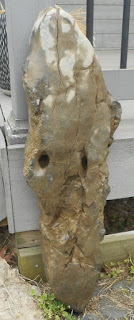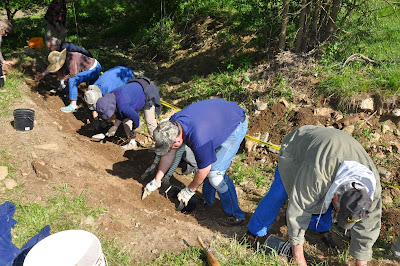Stacy Dodd and Rod Weber find, Jasper County, Missouri
Ken Johnston interpretation of a mammoth facing left with a crude human face depicted on its posterior. The mammoth has an eye divot in more or less anatomically correct position for such a depiction and may also have a tusk depicted. The sculpture stands upright in correct orientation. This is now a well-described North American portable rock art motif with other examples from the The Old Route 66 Zoo Site already seen on this blog.
Mammoth form with eye with rough human face depicted on its back end
This Old Route 66 Zoo Site sculpture found this Spring depicts a human head looking left and a lion head facing right
Cut out image of the human face depicted at left on the sculpture and opposite the lion head figure. Two short incised lines terminate at their intersection to form a "V-shape" nose on the human face.
Lion head right profile
There is a nested image of a second human face which may be seen within the lion head. The left eye of the second human mask is the right eye on the lion head figure (circled). This sharing of right and left eyes between the lion and human may have had symbolic meaning because it is seen in several examples.
Combined human and feline heads looking in opposite directions, Janus-like
These two sculptures from this site use the same artistic convention of a human head combined with an animal, facing in opposite directions. This is a convention well documented on this blog. The human head combined with animal head is one of the primary stone sculpture types of Paleolithic times according to author Pietro Gaietto.

























































